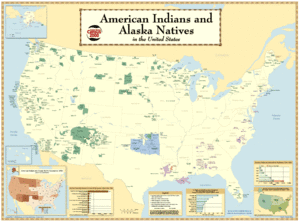 By Jean F. Andrews
By Jean F. Andrews
[Author’s Note: Dr. Paris is an assistant professor in the Dept of Deaf Studies/Deaf Education at Lamar University. She has done research with Native American Deaf Communities. — Jean Andrews]
Native American and Deaf Communities: Parallels of Oppression
Recently, the news has been rife with reports about the Washington Redskins and the controversy over their usage of “redskin” as their mascot. Native Americans began protesting in earnest during the Washington Redskin/Denver Bronco game and more protests are scheduled during future games. A good article to review about the historical connotation of the term “redskin” can be found here: http://www.npr.org/blogs/codeswitch/2013/09/09/220654611/are-you-ready-for-some-controversy-the-history-of-redskin
In many ways, there are parallels in how members of the Native American and Deaf communities have experienced oppression. It was not long ago that the Deaf community campaigned against offensive terms such deaf and dumb, deaf-mute and hearing-impaired. While increasingly infrequent in usage, such labels still crop up in the media.
These two distinct communities have endured tactics to homogenize their cultures into the majority, or dominant, community. In 1880, the infamous Milan conference passed a resolution that deaf students should be taught through oral methods, banning sign language in schools. For almost a hundred years, the native language of deaf individuals were suppressed, and reports of punishments of students who used sign language ranged from authority figures hitting their hands with rulers to banishment in isolating rooms.

This Census Bureau map depicts the locations of Native Americans in the United States as of 2000. (Photo credit: Wikipedia)
In 1879, one of the first Indian boarding schools (Carlisle in Pennsylvania) was established to remove Native American children (often forcibly and under threat of jailing their parents) from their tribal communities into schools that expected students to change their clothing, cut their hair, and discontinue use of their native languages. Many of these schools, under the guise of helping Native Americans assimilate into the European-American culture, would quell resistance of students through starvation, physical beatings and public humiliation. Many of these children were quite young when separated from their families, and were not allowed to contact them until after they graduated. Once they became adults, they did not return to their tribes and many of the customs and languages became dormant, or disappeared altogether.
Attempts at genocide impacted both cultures. Native Americans often refer to stories about settlers giving smallpox blankets to tribes to reduce their numbers, with some historians debunking these stories as myths. There has been documentation, however, of at least one incident shortly after the French and Indian War ended in 1763 in which a British general suggested to one of his subordinates that they use diseased-ridden blankets to reduce the Native American population. An outbreak occurred near Fort Pitt shortly after this dialogue occurred (Knollenberg, 1954). The prevailing viewpoint in the mid-1800’s was that the “only good Indian was a dead Indian” (Meider, 1993). Whether from smallpox blankets or war, the drastic reduction of the number of Native Americans over the centuries cannot be ignored.
This is not dissimilar to the Eugenics perspective in the 1800’s in which advancement of the human race was a key priority. One of the most famous eugenicists, Alexander Graham Bell, published articles that actively discouraged marriage between Deaf people in order to reduce the inheritance of deafness (Edwards, 2007). There have been published reports about the abuse, sterilization, and murder of deaf individuals during the Holocaust from 1933-1945 in Hitler’s quest for a master race (Ryan, 2005).
![This poster (from around 1938) reads: "60,000 Reichsmark is what this person suffering from a hereditary defect costs the People's community during his lifetime. Fellow citizen, that is your money too. Read '[A] New People', the monthly magazine of the Bureau for Race Politics of the NSDAP." Image: Wikipedia](http://deafinprison.com/wp-content/uploads/2013/07/enthanasiepropaganda.jpg?w=235)
This poster (from around 1938) reads: “60,000 Reichsmark is what this person suffering from a hereditary defect costs the People’s community during his lifetime. Fellow citizen, that is your money too. Read ‘[A] New People’, the monthly magazine of the Bureau for Race Politics of the NSDAP.” Image: Wikipedia
And there is evidence that these two cultures have actually intersected. Plains Indian Sign Language (PISL), shared by both deaf and hearing members of tribes in what was formerly known as the Plains, has been studied for its contributions to ASL (see http://helenair.com/lifestyles/tribal-hand-talk-considered-an-endangered-language/article_da41d7a8-a6a4-11df-9ff4-001cc4c03286.html). As two cultures that have visual languages in common, it is a pleasant discovery that approximately 30% of PISL can be found in ASL.
Edwards, R.A.R. (2007). Chasing Aleck: The story of a dorm. The Public Historian, 29 (3), pp.
87-104.
Knollenberg, B. (1954). General Amherst and germ warfare. The Mississippi Valley Historical
Review, 41 (3), pp. 489-94.
Meider, W. (1993). “The only good Indian is a dead Indian”: History and meaning of a
proverbial stereotype. The Journal of American Folklore, 106 (419), pp.38-60.
Ryan, D. F. (2005). Deaf people in Hitler’s Europe: Conducting oral history interviews with deaf
Holocaust survivors. Public Historian, 27(2), 43-52.
Jean F. Andrews is a Reading Specialist and Professor of Deaf Studies/Deaf Education at Lamar University.
[Editor’s note: DeafInPrison.com is very grateful to Dr. Paris for this wonderful contribution. In researching this article for the edit, I discovered that other than one of her references came from Jstor.org. Sadly, jstor is not a free service, and if you wished to do further study on your own, you would need an account. I did look for copies of these texts on Wikipedia and on Amazon, but they were not to be found. Hey, I don’t run the Internet – I just work there. — BitcoDavid]
Related articles
- Phoebe Tay: “For the first time in my life, I experienced the Deaf community becoming united at an international level” (limpingchicken.com)
- Germany Building Memorial To Hitler’s Euthanasia Victims (gadling.com)
- 25 Signs That America Is Rapidly Becoming More Like Nazi Germany (kevliberty.com)
- What the Pro-Life Movement and the Eugenics Movement Have In Common (rosesandrevolutionaries.wordpress.com)
- Female Inmates Sterilized In California (webpronews.com)
- Stop Hearing Loss Bullying Video Now Online (deafinprison.wordpress.com)
- Death in Custody: a PDF From the DOJ (deafinprison.wordpress.com)
- A Must See Video Says it All (deafinprison.wordpress.com)
- What He Said, and What it Says About Us (deafinprison.wordpress.com)
- Tufts ASL program sees growth in popularity, opportunities to interact with Deaf community (tuftsdaily.com)



Pingback: Happy Thanksgiving and Thank You for Reading Us | deafinprison